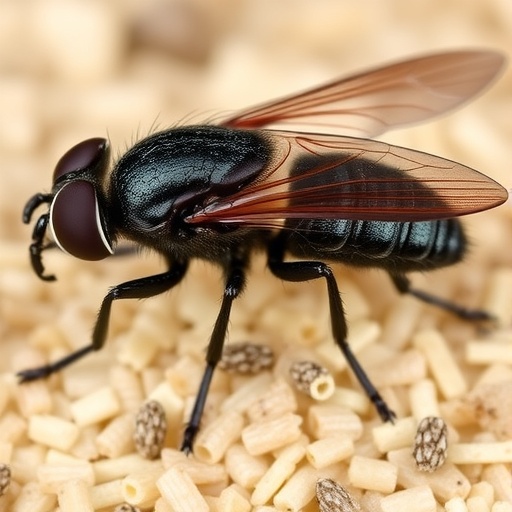In a groundbreaking study, researchers have turned their focus to the remarkable capabilities of black soldier fly larvae, specifically Hermetia illucens, in tackling one of the most pressing environmental issues of our time: plastic pollution. This innovative research sheds light on the potential of these larvae not only to thrive as professional decomposers but also to contribute significantly to the bioremediation of plastic waste. The implications of such findings are vast, offering a glimmer of hope in a world increasingly choked by synthetic materials.
At the crux of this investigation is the astounding appetite of Hermetia illucens larvae for various forms of plastic. The research team meticulously analyzed the larvae’s feeding habits, uncovering their ability to consume and break down polystyrene, a common yet notoriously non-biodegradable plastic. This opens up a myriad of opportunities for developing eco-friendly waste management solutions, as the larvae convert plastic into biomass and other byproducts, potentially transforming waste into useful resources.
The study employs a range of experimental conditions to elucidate how different types of plastic material influence the growth and survival of these larvae. The results indicate that not only can Hermetia illucens endure polystyrene, but they can also survive and grow on it as a sole source of nutrition. This highlights their unique adaptation and the evolutionary advantage they hold in environments rife with plastic waste.
Furthermore, the research explores the biochemistry behind this remarkable process. It delves into how the larvae’s gut microbiota plays a crucial role in the degradation of plastics, with specific microorganisms aiding in the breakdown of complex polymers. This symbiotic relationship suggests a high degree of specialization, and that Hermetia illucens could serve as a model organism for further studies aiming to harness microbial communities for environmental cleanup efforts.
The implications of harnessing black soldier fly larvae for plastic waste management could be vast. As nations grapple with increasing amounts of plastic pollution, traditional waste disposal methods often fall short. Landfills are rapidly filling up, and incineration raises significant environmental and health concerns. Integrating Hermetia illucens into waste management systems could illuminate pathways for sustainable solutions, steering society towards a circular economy model.
Beyond mere decomposition, the larvae also produce frass, a nutrient-rich byproduct that can be repurposed as a potent organic fertilizer. This opens up avenues for agricultural applications, where waste not only finds a second life but also enhances soil health. The conversion of plastic waste into valuable agricultural inputs could establish a closed-loop system that benefits both the environment and food production industries.
Additionally, researchers speculate about potential biotechnological applications stemming from their findings. The proteins and fats extracted from Hermetia illucens larvae can be utilized in various industries, including food, animal feed, and cosmetics. By integrating the larvae into different commercial sectors, businesses could significantly lessen their ecological footprints while simultaneously addressing the global challenge of plastic waste.
The research also scrutinizes the larvae’s ecological impact and the potential risks associated with their introduction into artificial environments. While the benefits are tantalizing, scientists underscore the importance of conducting thorough assessments to understand the long-term effects on local ecosystems. Responsible management and further studies will be paramount to ensure that the introduction of Hermetia illucens does not lead to unforeseen consequences.
Public perception plays a crucial role in the adoption of such innovative solutions for plastic pollution. Society must embrace the idea of utilizing insects in waste management and view them as allies rather than pests. Education campaigns focusing on the benefits of Hermetia illucens and other similar organisms can help encourage acceptance and investment in these novel approaches.
Moreover, this research’s findings hold significant implications for policy-making. Governments and environmental organizations must consider incentivizing technologies that harness biological agents like Hermetia illucens to mitigate plastic waste. By fostering a regulatory environment that supports such initiatives, stakeholders can potentially catalyze the shift towards a more sustainable and resilient ecosystem.
Scientists are calling for interdisciplinary collaborations to further explore the diverse applications of Hermetia illucens in ecological restoration and resource management. By joining forces with ecologists, biotechnologists, and policymakers, a comprehensive understanding of this larvae’s role in managing plastic pollution can be developed, leading to innovative and practical solutions.
This study represents a significant step forward in our understanding of insect contributions to tackling plastic waste. While further research is essential, the potential for Hermetia illucens to engage in effective bioremediation and promote sustainability is inspiring. As we strive to confront the challenges of environmental degradation, it is inevitable that we must look to nature for solutions that could transform our world for the better.
In conclusion, the exploration of the plastivorous activity of Hermetia illucens provides a glimpse into unprecedented ecological solutions. With their unique feeding habits and potential biotechnological applications, these larvae could spearhead environmentally sustainable methods to address one of humanity’s greatest challenges: plastic waste. While there’s much more to uncover in this field, the groundwork laid by this study could foster transformative change and usher in a new era of bioremediation efforts.
Subject of Research: The potential of Hermetia illucens larvae in plastic waste management.
Article Title: Exploring the plastivorous activity of Hermetia illucens (Diptera Stratiomyidae) larvae.
Article References:
Abenaim, L., Mercati, D., Mandoli, A. et al. Exploring the plastivorous activity of Hermetia illucens (Diptera Stratiomyidae) larvae. Environ Sci Pollut Res (2025). https://doi.org/10.1007/s11356-025-36952-w
Image Credits: AI Generated
DOI:
Keywords: Hermetia illucens, plastic waste management, bioremediation, sustainable solutions, ecological restoration.




